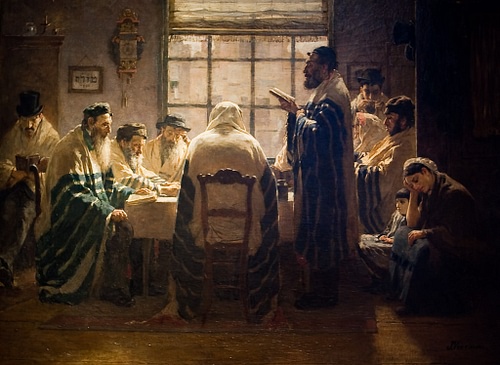
The Tallit is a garment worn by those of Jewish faith as a symbol of communal solidarity and devotion to their god. The foundation for modern Jewish socio-religious concepts is the Tanakh, or Hebrew bible which is also the Christian Old Testament. Within it, the first five books of the Masoretic Text (i.e. Bereʾšyt, Shemot, Vayikra, Bəmidbar, Devarim), or Torah, are where the Laws, traditions and early history of Hebrew culture are found. It is from here that traditional Israelite (or Israeli) material culture and national unity is originally derived. Principally, the טַלִּית, or tallit, functions as a reminder for Jews to remain constantly devoted to God. Moreover, it is also a symbol of Jewish solidarity within a Gentile world and may be understood through a Jewish/Gentile dichotomy.
However, it should be noted that modern Jewish identity is an extremely complex subject that easily fragmentizes into various yeshivas regarding religious beliefs (e.g. Orthodox, Conservative, Reformed) and political affiliations (e.g. Israeli-Likud, American-Democratic), which are further complicated by national allegiances (e.g. Israeli, Anglo-Jewry), social philosophies (e.g. Religious-Zionism, Socialism) and even genetic research. Simply put, many contemporary Jews do not wear the tallit. Considering the socially sensitive nature of the aforementioned, for the rest of this entry we will refer to 'Hebrews and Jews' and all anthropological interpretations of 'Judaism' in the Ultraorthodox context.
The Four Corners of the Garment
The origin of the tallit can be found in two clauses in Numbers 15:37-41 where God ordained the wearing of a 'tassel', ציצית or tzitzit, on each of the 'four corners' of a standard 'garment'. Practically speaking, medieval fashion trends frustrated the fulfilling of this commandment by not allowing tzitzit to be worn easily on everyday apparel. Consequently, the tallit was designed specifically to fulfill the obligation of wearing the tzitziyot. In this light, the tallit acts as a social bridge allowing Jews to function in the modern world (Cf. Deuteronomy 22:12). However, unlike the religious iconography from other cultures, a tzitzit is typically not thought to possess amuletic properties. Materialistically, the cultural significance of tzitziyot can only be understood through their tedious production process and by the social construct they signify to others.
For example, a tzitzit is fashioned on one of the corners of a tallit by tying seven white linen and one blue, or t'kheilet, wool strands of cloth five times for a sum of fifteen. Furthermore, rabbinic tradition fixes the numerical value of ציצית at six hundred. Collectively, the summation of all numbers (five, seven, one and six hundred) is six hundred and thirteen — the exact number of 'commandments' in the Torah. Hence, the Torah itself is immediately signified by the wearing of tzitziyot.
An interesting side note is that the special blue t'kheilet dye was employed in the sacred vesture of the Levitical High Priest. Given the deferential role the Levite tribe played within Hebrew society, the use of t'kheilet by non-Levitical Jews may infer a perception of communal 'holiness' for all Torah observant Jews regardless of tribal affiliation (Cf. Numbers 18:1-32).
The Passover in the Tallit
Another meaning for the tallit may be observed through a close examination of Judaic historiography and oral tradition. For example, the Biblical injunction to wear tzitziyot is intimately associated with the narrative of the Hebrew period in Egypt and their 'deliverance' (or independence and separation) from Pharaoh (Numbers 15:37-41; Cf. Exodus 12:37-51). Interestingly, these events are commemorated in the spring Feast of Passover, which historically is seen as the first festival (or 'independence day') of the ancient nation-state of Israel (Leviticus 23:4-5; Exodus 12:14, 13:5). Cosmologically, it may be inferred that Pharaonic Egypt is symbolic of ancient 'Gentile globalism' from which a 'Jewish nation' became independent (Cf. the Abrahamic rite of covenant in Genesis 17:7-16 with its post-Mosaic reinstitution in Joshua 5:3-5). Thus, a tzitzit might also be a sign of ancient Jewish nationalism. That being said, archaeological evidence from the Bar Kokhba Period (CE 132-136) reveals that Zealots were wearing tzitziyot during their war of 'liberation' from Roman occupation.
Fascinatingly, the young Rabbi Jesus from Nazareth, whose life would spark one of the great world religions, wore a tallit as he preached 'deliverance' to the inhabitants of Roman Palestine (Iudaea) (Mark 9:5; Luke 4:18). This is evidenced by the use of κράσπεδον when referencing the 'hem' (corner) of Christ's garment in Mathew 9:20 and 14:36. Κράσπεδον is the ancient Greek translation for tzitzit. Such a fact reminds one of the historical bonds between Jewish traditions and early Christianity. More importantly, it underscores the shared sociocultural structure in the religious messaging of both faiths. In summary, it may be argued that the contemporary tallit and tzitzit are a microcosmic diffusion of Hebrew faith, Jewish history, Levantine customs and Israeli nationalism. Thus, the sacred custom of wearing tallit publically may be viewed as a justifiable exercise in auto-segregation arising from a conscientious objection to the secularism of postmodern globalism.






